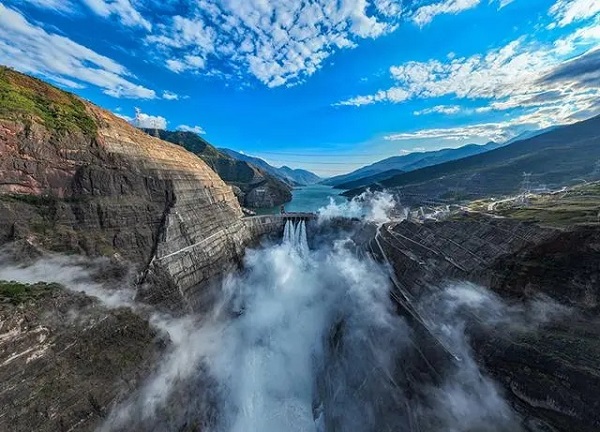The last generator unit of the Baihetan Hydropower Station was put into service on Dec 20, bringing into full operation of the hydropower station with the world's second-largest installed capacity.
Located in Ningnan County, Liangshan Yi Autonomous Prefecture in Southwest China's Sichuan Province, and Qiaojia County, Zhaotong in Southwest China's Yunnan Province, the Baihetan Hydropower Station is a major project in implementation of the country's west-to-east power transmission.
The station is mainly used for power generation and flood prevention as well as navigation. It has also played a key role in promoting regional economic and social development.

A bird's-eye view of the upstream face of the Baihetan Hydropower Station dam [Photo/sasac.gov.cn]
Construction of the main body of the station started in July 2017 and its first generator unit was put into operation on June 28, 2021.
Up till now, the station has generated more than 53 billion kilowatt-hours of power to regions like East China's Jiangsu and Zhejiang provinces.
Construction of the project was conducted against complicated geological conditions and innovative equipment was also developed. It's worth noting that environmental protection was also highly valued during construction.
The Baihetan Hydropower Station and the Wudongde, Xiluodu, Xiangjiaba, Three Gorges, and Gezhouba cascade hydropower stations over the trunk streams of the Yangtze River form the world's largest clean energy corridor.
The six hydropower stations are now equipped with 110 generator units and have a total installed capacity of nearly 71.70 million kilowatts.

A bird's-eye view of the downstream face of the Baihetan Hydropower Station dam [Photo/sasac.gov.cn]
According to China Three Gorges Corporation, the energy corridor stretches 1,800 kilometers and forms a 91.9 billion-cubic-meter cascade reservoir cluster and strategic freshwater resource pool. The flood control capacity reaches 37.6 billion cubic meters, accounting for more than 53 percent of the total flood control capacity of the Yangtze River that has been included in the country's joint distribution system in 2022. It is of great significance in guaranteeing flood control, power generation, navigation, utilization of the water resource and ecological security of the Yangtze River Basin.
Upon completion of the energy corridor, the six cascade hydropower stations are expected to generate 300 billion kWh annually, which will relieve power shortages in Central and East China, and Sichuan, Yunnan and Guangdong provinces. It will also support safe and stable operation of the west-to-east power transmission project and power grid.
In addition, the clean power generated by the energy corridor annually can help reduce about 90.45 million metric tons of coal or about 248.4 million tons of carbon dioxide emissions, which will contribute to the improvement of China's energy structure and realization of the country's "dual carbon" goals of peaking carbon dioxide emissions by 2030 and reaching carbon neutrality by 2060.
(Executive editor: Wang Ruoting)